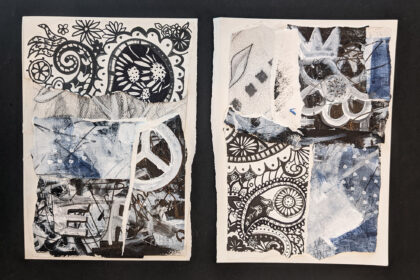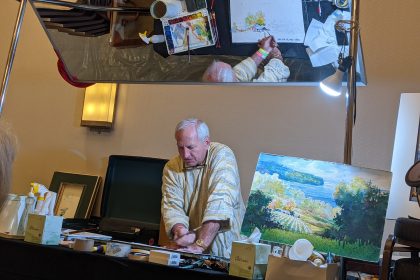For those following along with Dimitra Milan’s captivating “Bold Botanicals” workshop, Day 2 was a masterclass in layering, light, and bringing floral subjects to life on canvas. Here’s a glimpse into the artistic journey that unfolded.
The Foundation: Killing the White
Day 2 kicked off with the intention of laying down a thin, transparent first layer of paint. The goal? To “kill the white” of the canvas, creating a subtle undertone for the vibrant botanicals to come. Using a mix of Galkyd Lite and SoyThin paint thinner, participants aimed for a delicate wash. As one attendee humorously noted, sometimes the artistic process involves a bit of playful imperfection.
Now that the first wash layer is dry, we are diving into the middle “messy” layer with opaques, both cool and warm. Dimitra encouraged to load the palette up with colors so that each time you dip the brush, you can mix the color with a slightly different tint. So, you can shift a pink to the blue side, or the orange side, or make it more lavender or turquoise.
She also encouraged us to glaze any flowers that didn’t look “juicy” or shiny and covered in Galkyd Lite (without any thinner).
Resolving the background
Dimitra suggested that if you have a lot of colors in your background or you just really don’t know what to do with it, beige, gray, creamy white neutrals are always a good choice. And she demonstrated dry brushing, loading up the brush with paint and allowing it to glide across the canvas horizontally to leave a textured appearance.
Blocking In with Cools and Warms
With the initial layer in place, the focus shifted to blocking in the florals. After glazing, Dimitra suggested we add in our opaques and resolved some of the background areas by covering up any places that did not spark joy or to help define botanical edges whether that is making them sharper or blending them in with loose or lost edges. Dimitra guided students in strategically using cool tones to recede elements into the background and warm tones to bring subjects forward, creating depth and dimension in their botanical compositions. This thoughtful application of color is key to making the flowers truly pop into the foreground.
Subtractive Highlights and Defining Darks
A fascinating technique employed on Day 2 involved using everyday items – cotton swabs and makeup sponge wedges – to subtract highlights from the flowers. This method allows for delicate control over light and form, adding a soft luminosity to the petals.
While some students incorporated vases into their compositions, leading to the addition of dark shadows on the table surface, a universal step for all was defining the darker areas within the flowers themselves. This crucial step provides contrast and helps to give the florals their vibrant, three-dimensional quality.
The Art of Knowing When to Stop
One valuable takeaway from Day 2 was the importance of knowing when a painting has reached a good stopping point. As one participant shared, the desire to avoid overworking a piece or making a mess led to an early, yet satisfying, conclusion to their own painting. Witnessing Dimitra’s process of adding darks and shadows to make her flowers truly sing was an inspiring moment, offering insights into refining and enhancing the artwork.
Continuing the Journey
Dimitra Milan’s “Bold Botanicals” workshop is more than just a painting class; it’s an exploration of artistic intuition, color theory, and the joy of creating. Day 2 provided invaluable lessons in building layers, manipulating light, and bringing botanical subjects to life with confidence and artistic flair. We can’t wait to see what Day 3 and beyond will bring!




